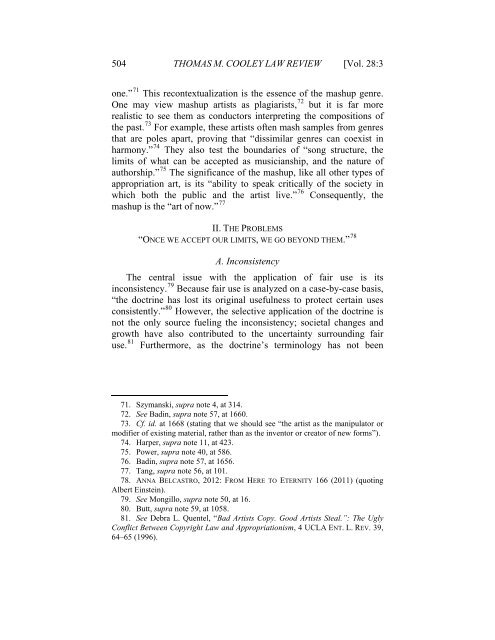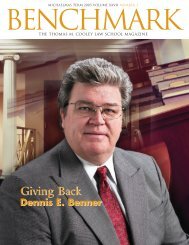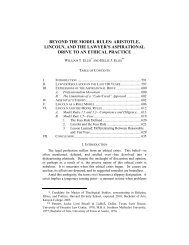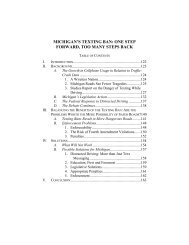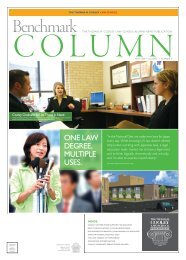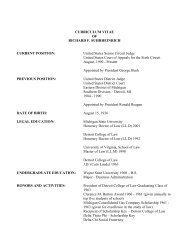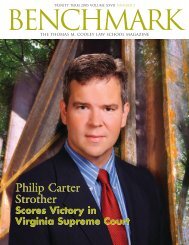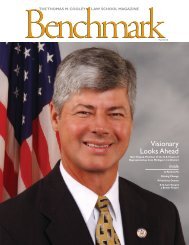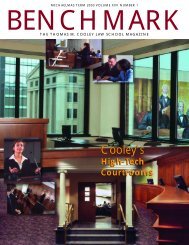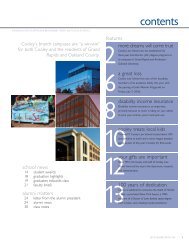Blanch It, Mix It, Mash It - Thomas M. Cooley Law School
Blanch It, Mix It, Mash It - Thomas M. Cooley Law School
Blanch It, Mix It, Mash It - Thomas M. Cooley Law School
Create successful ePaper yourself
Turn your PDF publications into a flip-book with our unique Google optimized e-Paper software.
504 THOMAS M. COOLEY LAW REVIEW [Vol. 28:3<br />
one.” 71 This recontextualization is the essence of the mashup genre.<br />
One may view mashup artists as plagiarists, 72 but it is far more<br />
realistic to see them as conductors interpreting the compositions of<br />
the past. 73 For example, these artists often mash samples from genres<br />
that are poles apart, proving that “dissimilar genres can coexist in<br />
harmony.” 74 They also test the boundaries of “song structure, the<br />
limits of what can be accepted as musicianship, and the nature of<br />
authorship.” 75 The significance of the mashup, like all other types of<br />
appropriation art, is its “ability to speak critically of the society in<br />
which both the public and the artist live.” 76 Consequently, the<br />
mashup is the “art of now.” 77<br />
II. THE PROBLEMS<br />
“ONCE WE ACCEPT OUR LIMITS, WE GO BEYOND THEM.” 78<br />
A. Inconsistency<br />
The central issue with the application of fair use is its<br />
inconsistency. 79 Because fair use is analyzed on a case-by-case basis,<br />
“the doctrine has lost its original usefulness to protect certain uses<br />
consistently.” 80 However, the selective application of the doctrine is<br />
not the only source fueling the inconsistency; societal changes and<br />
growth have also contributed to the uncertainty surrounding fair<br />
use. 81 Furthermore, as the doctrine’s terminology has not been<br />
71. Szymanski, supra note 4, at 314.<br />
72. See Badin, supra note 57, at 1660.<br />
73. Cf. id. at 1668 (stating that we should see “the artist as the manipulator or<br />
modifier of existing material, rather than as the inventor or creator of new forms”).<br />
74. Harper, supra note 11, at 423.<br />
75. Power, supra note 40, at 586.<br />
76. Badin, supra note 57, at 1656.<br />
77. Tang, supra note 56, at 101.<br />
78. ANNA BELCASTRO, 2012: FROM HERE TO ETERNITY 166 (2011) (quoting<br />
Albert Einstein).<br />
79. See Mongillo, supra note 50, at 16.<br />
80. Butt, supra note 59, at 1058.<br />
81. See Debra L. Quentel, “Bad Artists Copy. Good Artists Steal.”: The Ugly<br />
Conflict Between Copyright <strong>Law</strong> and Appropriationism, 4 UCLA ENT. L. REV. 39,<br />
64–65 (1996).


